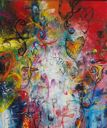Ford Crull
American
(Boston, Massachusetts, 1952 - )
The employment of personal symbols in art is not a modern phenomenon, but their use has taken on new meanings in the modern world. Intuition is a powerful tool for the artist who is willing to trust it, and for Ford Crull intuition is at the heart of his painting. “The painting evolves, and I often feel that it’s ahead of me,” he says. “It begins to go in a certain direction and I don’t always have anything to say about it. I want to put an image here, and the painting says, no, it goes there. At a certain point it tells me that it’s complete.” (1) Crull combines oil and encaustic media to produce complex, textured, mural-scale paintings that are luminous collections of drawn and painted imagery. Letters and words, organic and geometric shapes all jockey for space at different visual levels in a glowing field of color. Many of these forms are derived from earlier art, including the esoteric symbologies of Mayan, Byzantine, Celtic, and Egyptian cultures. (2) With these references, Crull creates a connection between the art of the past and his own creativity, as he appropriates the spiritual power and authority of ancient symbols. Assimilating these symbols with his own, he fashions images that are at once innovative and traditional, abstract yet textural, layered with information but remaining enigmatic. Crull’s approach depends on a number of artistic precedents, most importantly the Surrealist desire to explore the unconscious as a source of pure, often childlike, creativity unfettered by the conditioning of civilization. Crull studied the theories of French Surrealist André Masson (1896–1987), and also those of Wassily Kandinsky (1866–1944), whose book Concerning the Spiritual in Art (1912) defined, among other concepts, the important role of the subconscious in art. The result is a highly personal collection of symbols that, taken as a whole, create a specific narrative. “I want the imagery to stay alive, to keep moving, because I want your eye to keep moving constantly,” Crull has explained. “There’s a red story to follow, a green story, a yellow story.” (3) From the French Symbolist Odilon Redon (1840–1916), he has taken a belief in the power of art to suggest universal concepts, free of the restrictions of time and space. The artist’s instinctual combination of shapes and forms creates a distinct object with its own unique identity.
(1) Ford Crull, quoted in Ford Crull: Utopia, essay by Carter Ratcliff (Montgomery: The Montgomery Museum of Fine Arts, 2000), p. 3.
(2) Ibid., p. 4.
(3) Ibid., p. 7.
American Paintings from the Montgomery Museum of Fine Arts, 2006, cat. no. 107, p. 246.
American
(Boston, Massachusetts, 1952 - )
The employment of personal symbols in art is not a modern phenomenon, but their use has taken on new meanings in the modern world. Intuition is a powerful tool for the artist who is willing to trust it, and for Ford Crull intuition is at the heart of his painting. “The painting evolves, and I often feel that it’s ahead of me,” he says. “It begins to go in a certain direction and I don’t always have anything to say about it. I want to put an image here, and the painting says, no, it goes there. At a certain point it tells me that it’s complete.” (1) Crull combines oil and encaustic media to produce complex, textured, mural-scale paintings that are luminous collections of drawn and painted imagery. Letters and words, organic and geometric shapes all jockey for space at different visual levels in a glowing field of color. Many of these forms are derived from earlier art, including the esoteric symbologies of Mayan, Byzantine, Celtic, and Egyptian cultures. (2) With these references, Crull creates a connection between the art of the past and his own creativity, as he appropriates the spiritual power and authority of ancient symbols. Assimilating these symbols with his own, he fashions images that are at once innovative and traditional, abstract yet textural, layered with information but remaining enigmatic. Crull’s approach depends on a number of artistic precedents, most importantly the Surrealist desire to explore the unconscious as a source of pure, often childlike, creativity unfettered by the conditioning of civilization. Crull studied the theories of French Surrealist André Masson (1896–1987), and also those of Wassily Kandinsky (1866–1944), whose book Concerning the Spiritual in Art (1912) defined, among other concepts, the important role of the subconscious in art. The result is a highly personal collection of symbols that, taken as a whole, create a specific narrative. “I want the imagery to stay alive, to keep moving, because I want your eye to keep moving constantly,” Crull has explained. “There’s a red story to follow, a green story, a yellow story.” (3) From the French Symbolist Odilon Redon (1840–1916), he has taken a belief in the power of art to suggest universal concepts, free of the restrictions of time and space. The artist’s instinctual combination of shapes and forms creates a distinct object with its own unique identity.
(1) Ford Crull, quoted in Ford Crull: Utopia, essay by Carter Ratcliff (Montgomery: The Montgomery Museum of Fine Arts, 2000), p. 3.
(2) Ibid., p. 4.
(3) Ibid., p. 7.
American Paintings from the Montgomery Museum of Fine Arts, 2006, cat. no. 107, p. 246.
Artist Objects
